Collection: St. Margaret Mary Alacoque
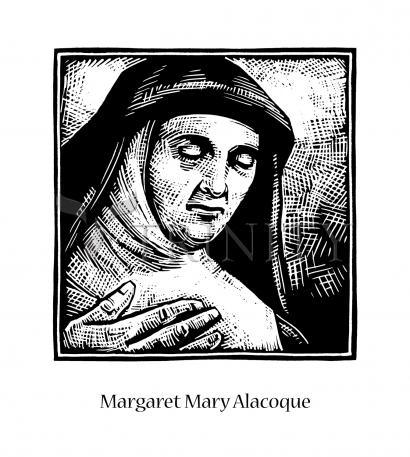
-
Sale
Wood Plaque Premium
Regular price From $99.95 USDRegular priceUnit price per$111.06 USDSale price From $99.95 USDSale -
Sale
Wood Plaque
Regular price From $34.95 USDRegular priceUnit price per$38.83 USDSale price From $34.95 USDSale -
Sale
Wall Frame Espresso
Regular price From $109.95 USDRegular priceUnit price per$122.17 USDSale price From $109.95 USDSale -
Sale
Wall Frame Gold
Regular price From $109.95 USDRegular priceUnit price per$122.17 USDSale price From $109.95 USDSale -
Sale
Wall Frame Black
Regular price From $109.95 USDRegular priceUnit price per$122.17 USDSale price From $109.95 USDSale -
Sale
Canvas Print
Regular price From $84.95 USDRegular priceUnit price per$94.39 USDSale price From $84.95 USDSale -
Sale
Metal Print
Regular price From $94.95 USDRegular priceUnit price per$105.50 USDSale price From $94.95 USDSale -
Sale
Acrylic Print
Regular price From $94.95 USDRegular priceUnit price per$105.50 USDSale price From $94.95 USDSale -
Sale
Giclée Print
Regular price From $19.95 USDRegular priceUnit price per$22.17 USDSale price From $19.95 USDSale -
Custom Text Note Card
Regular price From $300.00 USDRegular priceUnit price per$333.33 USDSale price From $300.00 USDSale
ARTIST: Julie Lonneman
ARTWORK NARRATIVE:
St. Margaret Mary Alacoque, a French Roman Catholic Visitation nun and mystic, is greatly recognized for her devotion to the Sacred Heart of Jesus.
Margaret had always shown an intense love for the Blessed Sacrament and preferred silence over typical childhood play. She began practicing severe corporal mortification after her first communion at 9-years-old.
She continued this until rheumatic fever confined her to her bed for four years. After making a vow to the Blessed Virgin Mary to consecrate herself to religious life, Margaret instantly returned to perfect health. In recognition of this favor, Margaret added the name Mary to her baptismal name.
“Go courageously to God, along the way He has traced out for you, steadfastly embracing the means He offers you.” “May faith be the torch which illuminates, animates, and sustains you.” “But above all preserve peace of heart. This is more valuable than any treasure.”
–Saint Margaret Mary Alacoque
Her feast day is October 17.
- Art Collection:
-
Saints & Angels
- Patronage:
-
Polio Patients,
-
Devotees of the Sacred Heart,
-
Loss of Parents
- Lonneman collection:
-
Models of Faith
Margaret Mary was chosen by Christ to arouse the Church to a realization of the love of God symbolized by the heart of Jesus.
Her early years were marked by sickness and a painful home situation. “The heaviest of my crosses was that I could do nothing to lighten the cross my mother was suffering." After considering marriage for some time, Margaret Mary entered the Order of the Visitation nuns at the age of 24.
A Visitation nun was “not to be extraordinary except by being ordinary," but the young nun was not to enjoy this anonymity. A fellow novice termed Margaret Mary humble, simple, and frank, but above all, kind and patient under sharp criticism and correction. She could not meditate in the formal way expected, though she tried her best to give up her “prayer of simplicity." Slow, quiet, and clumsy, she was assigned to help an infirmarian who was a bundle of energy.
On December 21, 1674, three years a nun, she received the first of her revelations. She felt “invested" with the presence of God, though always afraid of deceiving herself in such matters. The request of Christ was that his love for humankind be made evident through her.
During the next 13 months, Christ appeared to her at intervals. His human heart was to be the symbol of his divine-human love. By her own love Margaret Mary was to make up for the coldness and ingratitude of the world—by frequent and loving Holy Communion, especially on the first Friday of each month, and by an hour's vigil of prayer every Thursday night in memory of his agony and isolation in Gethsemane. He also asked that a feast of reparation be instituted.
Like all saints, Margaret Mary had to pay for her gift of holiness. Some of her own sisters were hostile. Theologians who were called in declared her visions delusions and suggested that she eat more heartily. Later, parents of children she taught called her an impostor, an unorthodox innovator. A new confessor, the Jesuit Claude de la Colombière, recognized her genuineness and supported her. Against her great resistance, Christ called her to be a sacrificial victim for the shortcomings of her own sisters, and to make this known.
After serving as novice mistress and assistant superior, Margaret Mary died at the age of 43, while being anointed. She said: “I need nothing but God, and to lose myself in the heart of Jesus."
Additional Items Our Customers Like
-
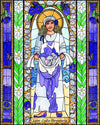
St. Lydia Purpuraria (by Brenda Nippert)
-
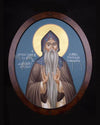
St. Macarius the Great (by Br. Robert Lentz, OFM)
-
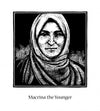
St. Macrina the Younger (by Julie Lonneman)
-
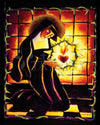
St. Margaret Mary Alacoque (by Br. Mickey McGrath, OSFS)
-
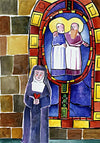
St. Margaret Mary Alacoque at Window (by Br. Mickey McGrath, OSFS)
-
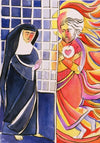
St. Margaret Mary Alacoque, Cloister (by Br. Mickey McGrath, OSFS)


















